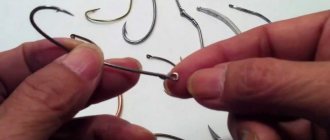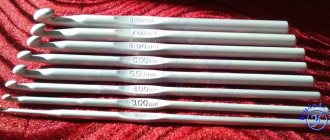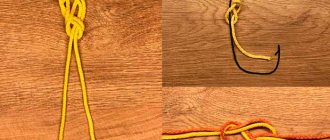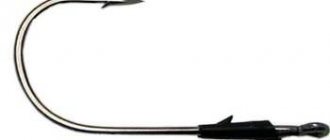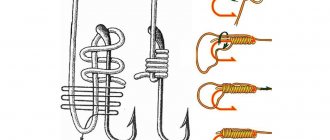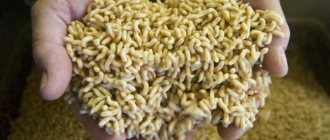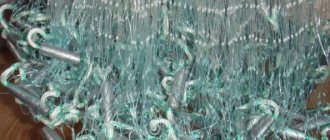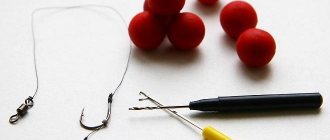Crochet hooks
The golden rule of needlework is to start working with a complete understanding of its basics. Speaking about crocheting, you can “decipher” it like this: you need to start knitting a product by choosing the right yarn, finding the right tool and mastering all the stitches that are used in the work. At this stage, a legitimate question arises: how to choose a crochet hook if this information is not indicated in the product description?
The question is serious. By choosing the wrong hook, you can ruin the product just after you start knitting it. The canvas may turn out to be too dense or, conversely, with huge gaps between the columns. If the hook is chosen incorrectly, the transitions between rows will look awkward. And it’s unlikely that you’ll be able to knit an item of a certain size—the item either won’t fit on you or will hang completely. That is why it is so important to find a middle ground - in knitting this is not even half the success, but much more.
Choosing a crochet hook based on appearance
When thinking about which crochet hook to choose, everyone will first of all pay attention to the appearance. The first step is to determine which tool is more convenient. Comfort of knitting is a subjective characteristic. What one needlewoman likes will be unacceptable to another. Therefore, everything written below is of an overview nature. The choice is the right and responsibility of the needlewoman herself.
Crochet hook material
The first thing you need to pay attention to is what the hook is made of. The material and the quality of its processing are important. Hooks made from different materials should be sorted based on cost and convenience requirements.
Plastic hook
Plastic crochet hook
The most common and cheapest material is plastic. Hooks of different colors, shapes and sizes are made from it.
Advantages : low price, ease of use, large selection of sizes and manufacturers.
Disadvantages : small hooks are brittle, creaking when in contact with some yarn.
Wooden (bamboo) hook
Crochet hook made of bamboo (wood)
Has the same shape as a plastic hook. Looks prettier and available at almost every craft store.
Advantages: pleasant texture, good glide if the manufacturing technology is followed, pleasant appearance.
Disadvantages : fragility, rather high price.
Aluminum hook
Aluminum crochet hook
Similar to plastic and bamboo hooks. It has a characteristic metallic luster and makes a corresponding sound when dropped on a hard surface.
Advantages : low price (comparable to the price of a plastic hook), good glide, always available in stores, the hook is difficult to break.
Disadvantages : small hooks bend and often slip out of your hands when knitting.
Steel hook
Steel crochet hook
Combines the advantages of all of the above types of crochet. Less popular among beginners, common among experienced needlewomen.
Advantages : strength of hooks of all sizes, good glide, difficult to break the hook.
Disadvantages : higher price than plastic and aluminum hooks.
Combination hook with handle
Combination hook: plastic handle and aluminum tip
Combination hook: wooden handle and steel tip
It combines several materials and consists of two elements - the handle and the hook itself. The handle is usually made of plastic or wood, the tip is made of aluminum or steel. It’s not convenient for everyone, but it offers a lot of choice. The handle can be either straight or curved.
Advantages : the ability to choose a handle that is convenient for you, a wide selection of materials.
Disadvantages : often the hook itself falls off the handle (irrelevant for good manufacturers).
Which hook is more convenient?
A hook made of each material is convenient in its own way. For openwork products, steel and combination hooks are most often used. When knitting shawls, capes and stoles, preference is given to aluminum and wooden hooks. Products made from thick yarn are knitted with large plastic hooks. This list can be continued endlessly.
Each product has its own hook. This phrase slightly exaggerates the essence of what is happening, but on the whole it is true. It's best to have all kinds of hooks in your craft chest. It is much more important to figure out how to understand which crochet to knit. More on this in the second part of the article.
Crochet hook length: what affects
Conventionally, crochet hooks are usually divided into long and short. Few people know about this classification. Different hooks are used in fundamentally different knitting techniques.
Different types of short crochet hooks
The short hook has a length of 12-15 centimeters. This is a standard hook used to knit hats, scarves, toys, blankets and other yarn items familiar to the eye.
Tunisian crochet hook with fishing line
The long hook has a length of 20-40 centimeters. It is most often made of wood and is used only for Tunisian knitting. This is a fundamentally different crochet technique; it is not widely used. Hooks for Tunisian crochet can be with or without fishing line. For regular knitting, such a hook will be inconvenient.
If you are just starting to crochet and don’t yet know what technique you will use, buy a short hook. It's universal. The Tunisian knitting technique should be used at an advanced level.
Hook thickness is key
The title itself suggests that the thickness of the hook is the first thing you need to pay attention to when choosing it. A crochet hook can be very convenient, but it is not suitable for yarn. Then the product simply won’t work. And even if it works out, it won’t be pretty.
The thickness of the yarn hook is classified as follows, based on the diameter (indicated in parentheses):
- Ultra-thin hooks (0.5-1 mm). Used for knitting openwork napkins, collars, and Irish lace elements.
- Thin hooks (1-2 mm). They are used mainly for knitting summer items made of cotton and viscose. Thin hooks are used when knitting children's clothing and joining motifs.
- Medium hooks (2-5 mm). The most common type of crochet in terms of thickness. Used for knitting scarves, hats, blankets, stoles, toys. The most popular size is 4 mm.
- Thick hooks (6-20 mm). In fact, there are also much larger diameters. Used in knitting from knitted and plush yarns, as well as in the manufacture of rugs. Knitting from thick yarn is a large category that requires separate consideration.
The diameter of the hook must match the diameter of the yarn . This means that the thickness of the hook should be equal to the thickness of the yarn. It is possible to take a hook a little thinner than the yarn. The thickness of the yarn in millimeters is indicated on the packaging. Don't know where to look? Read on.
What types of crochet hooks are there?
For different knitting techniques, tools may differ slightly:
- For regular knitting, the simplest ones are suitable. There are many of them on sale and they differ from each other only in size, material from which they are made, and design options.
- For the Tunisian knitting technique, long hooks with stops or similar in appearance to circular knitting needles are used.
- For tatting, instruments are purchased that are long and thin along the entire length, with a smaller head, unlike the usual one.
Hooks can be made from a variety of materials: metal, plastic, wood. There are also bamboo and bone ones. How to choose a crochet hook when all this variety makes your head spin? There are several general recommendations that will help you avoid mistakes.
How to choose a hook for yarn
The task of choosing the size of a hook for yarn can arise in several cases:
- the product description does not indicate the hook number,
- there is no label on the yarn package (or it was lost),
- you want to knit a designer product,
- you are knitting an unusual pattern.
All eyes on the label
The first thing to do is pick up the yarn from which you are going to knit. It always has a label with information about the manufacturer, composition, color code and batch number. The recommended hook size is usually indicated on the label . Where exactly to find it and how it is marked - see below.
Deciphering the yarn label
Looking for information on the Internet
Every needlewoman has lost a skein label at least once. But if you also know the name of the yarn, the problem is almost solved. By entering the name of the yarn into the search, you can easily get to the manufacturer’s website. On it you can see a photo of the label, which shows the recommended hook size. Some manufacturers take care of their customers and provide ready-made information in the description of the yarn. Your task is to look carefully, then the problem will be solved.
We look at the length of the thread
This method will be useful if you know the footage and weight of the skein. They may be listed on the label (in the absence of a recommended hook size) or simply in your memory.
Below are approximate data in the following format: yarn length (in 100 grams) - corresponding hook size.
- 100 meters - a hook with a diameter of 5-6 mm.
- 150 meters - a hook with a diameter of 4-5 mm.
- 200-300 meters - a hook with a diameter of 3-4 mm.
- 300-500 meters - a hook with a diameter of 1.5-2 mm.
The trend is this: the more meters of yarn that fit in a skein weighing 100 grams, the smaller the hook diameter.
Selecting the hook size manually is easy
If you've lost the label and don't know the weight or yardage, you can determine your yarn hook size by hand. This method is a normal selection.
- Take hooks of different diameters . It is better to get even those hooks that, in your opinion, are least suitable. You need to try them too.
- Place the yarn in front of you . Identify a set of hooks that seem to work better than others at first glance.
- Start picking up the hook. Correlate the thickness of the yarn and the size of the hook. They must be equal. The thickness of the hook is determined by its working part - the rod. How to find the rod - look at the photo below.
Hook shank - how to find - Insert the thread into the notch of the hook. It should not fall out of the recess due to its large size (overlap the hook), but at the same time it should not leave a lot of empty space. Too small, too big and the perfect hook is in the photo below.
The hook is ideal for this yarn
The hook is too small for this yarn
The hook is too big for this yarn - Set aside hooks that are close to the thickness of the yarn . There should be 2-3 of them left with a difference in diameter of 1-2 mm.
- Knit a sampler with each hook . Cast on a chain of air loops. Crochet several rows of single crochets with one crochet hook, then with the other. Visually determine in which case the canvas turned out better. Select the hook that best suits your needs.
Hook size
The hook material will not affect the quality of knitting in any way, so you can choose what you like. What is more important is the size. When you look at the hook, you will notice that it has a number on it, sometimes with the letters “mm” added. This number corresponds to the thickness of the head (at the tip of the shaft). It is according to this parameter that the hook for the yarn is selected.
The smallest size is 0.5 mm. It is used when knitting with regular threads or iris yarn.
0.6-1.75 mm – for fine yarn made from 100% cotton.
2-3.5 mm – for yarn of medium thickness.
4-5 mm – for medium-thick yarn with double twist.
5-6 mm – double fluffy yarn.
7-8 mm – thick wool threads.
9 mm or more – thick twisted thread.
Secrets of choosing a hook
The above describes a fully working algorithm for choosing a hook for a specific yarn. But there are a few more points that are worth paying attention to.
Taking knitting technique into account is a must
Each needlewoman has her own knitting technique. What does it mean? Some people knit very tightly, others are used to knitting loosely. Usually a middle option is required, without extremes.
If you knit very tightly, take a hook 0.5-1 mm larger than the recommended size. This will make the knitting a little weaker - this will only be beneficial.
If you knit freely, take a hook 0.5-1 mm smaller than the recommended size. This will make the fabric moderately dense.
Does the hook size depend on the pattern?
There are patterns for which the hook size is determined specifically. Therefore, having chosen an unusual pattern, study in detail the information about its knitting. Often a diagram is not enough. Therefore, read the descriptions, watch the video with advice from experienced needlewomen.
For example, when knitting with plush yarn, you need to use a smaller hook. This is the only way to avoid holes in the canvas and prevent a situation with filler sticking out from under the loops.
Matching yarn and hook size
Now let's look at which hook to use for your yarn.
If the yarn still has a tag, inspect it. Manufacturers indicate on it the size of the yarn, what material it is made of, as well as the recommended sizes of hook and knitting needles.
Important! The sizes specified by the manufacturer are suitable for knitting clothes, napkins and other things. For toys, take a hook 1-1.5 mm smaller than stated.
Why is that? To knit clothes, the fabric should be quite soft and not loose. When knitting amigurumi toys, the density of the fabric is very important so that the filler does not stick out through it. This density is ensured by choosing a smaller hook. For example, for YarnArt Jeans yarn, the manufacturer recommends a 3.5 mm hook. Amigurumi craftswomen use a tool size of 2-2.5 mm for these threads.
What if the yarn tag is lost?
There are several ways to determine the appropriate hook size:
Method 1. The thickness of the tool is taken to be twice as thick as the thickness of the thread. How to determine? Stretch the yarn and measure the diameter with a ruler. Multiply the resulting number by 2.
Method 2. Place a thread on the beard and pull it tight. The size is suitable if the thread is level or higher (for toys) with the level of the beard.
As you can see, the beard and yarn are at the same level, which means they fit together. YarnArt Jeans, hook No. 2
Method 3. Ideal crochet hook for amigurumi. Knit a circle of amigurumi (5-6 rows) with the selected crochet hook and yarn. The size is suitable if the circle is tight and flat, without holes, does not curl, does not cup, and does not go in waves.
The photo below shows an example of knitting an amigurumi circle with YarnArt Violet yarn and 2 mm, 1 mm and 0.6 mm hooks. In the case of No. 0.6, the knitting began to curl into a cup; the hook did not fit. At 2 mm, the amigurumi circle is even, but there are large gaps between the loops, the knitting fabric is soft. Good for knitting clothes, but this hook-yarn combination is not suitable for toys. The filler is visible through the gaps between the loops, and over time they will stretch, the toy will become deformed, and the filler will fall out. But at 1 mm the canvas is dense, the circle is even - an excellent solution for toys. .
